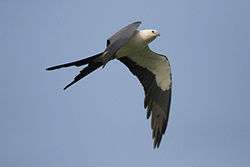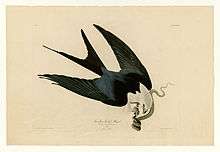Swallow-tailed kite
- For the African species, see African swallow-tailed kite
| Swallow-tailed kite | |
|---|---|
 | |
| Scientific classification | |
| Kingdom: | Animalia |
| Phylum: | Chordata |
| Class: | Aves |
| Order: | Accipitriformes |
| Family: | Accipitridae |
| Subfamily: | Elaninae |
| Genus: | Elanoides Vieillot, 1818 |
| Species: | E. forficatus |
| Binomial name | |
| Elanoides forficatus (Linnaeus, 1758) | |
| Subspecies | |
| |
| Synonyms | |
| |
The swallow-tailed kite (Elanoides forficatus) is an elanid kite which breeds from the southeastern United States to eastern Peru and northern Argentina. Most North and Central American breeders winter in South America where the species is resident year round. It was formerly named Falco forficatus.
Taxonomy and systematics
The swallow-tailed kite was first described as the "swallow-tail hawk" and "accipiter cauda furcata" (forked-tail hawk) by the English naturalist Mark Catesby in 1731.[2] It was given the binomial scientific name Falco forficatus by Carl Linnaeus in the 10th edition of Systema Naturae, published in 1758;[3] he changed this to Falco furcatus in the 12th edition of 1766.[4] The latter spelling was used widely during the 18th and 19th centuries, but the original spelling has precedence. The genus Elanoides was introduced by the French ornithologist Louis Jean Pierre Vieillot in 1818.[5][6] The name is from Ancient Greek elanos for "kite" and -oides for "resembling".[7]
Description

The species is 50 to 68 cm (20 to 27 in) in length, with a wingspan of approximately 1.12–1.36 m (3.7–4.5 ft). Male and female individuals appear similar. The body weight is 310–600 g (11–21 oz).[8][9] The body is a contrasting deep black and white. The flight feathers, tail, feet, bill are all black. Another characteristic is the elongated, forked tail at 27.5–37 centimetres (10.8–14.6 in), hence the name swallow-tailed. The wings are also relatively elongated, as the wing chord measures 39–45 cm (15–18 in). The tarsus is fairly short for the size of the bird at 3.3 cm (1.3 in).[10]
Young swallow-tailed kites are duller in color than the adults, and the tail is not as deeply forked.
Habitat and behavior

Swallow-tailed kites inhabit mostly woodland and forested wetlands near nesting locations. Nests are built in trees, usually near water. Both male and female participate in building the nest.
Sometimes a high-pitched chirp is emitted, though the birds mostly remain silent.
Diet
The swallow-tailed kite feeds on small reptiles, such as snakes and lizards. It may also feed on small amphibians such as frogs; large insects, such as grasshoppers, crickets; small birds and eggs; and small mammals including bats. It has been observed to regularly consume fruit in Central America.[11] It drinks by skimming the surface and collecting water in its beak.
Reproduction
Mating occurs from March to May, with the female laying 2 to 4 eggs. Incubation lasts 28 days, and 36 to 42 days to fledge.
Conservation in the United States
Swallow-tailed kites are not listed as endangered or threatened by the federal government in the United States. They are listed as endangered by the state of South Carolina and as threatened by the state of Texas. They are listed as "rare" by the state of Georgia. Destruction of habitats is chiefly responsible for the decline in numbers. A key conservation area is the Lower Suwannee National Wildlife Refuge in Florida.
References
- Sources
- Stiles and Skutch, A guide to the birds of Costa Rica ISBN 0-8014-9600-4
- Notes
- ↑ BirdLife International (2012). "Elanoides forficatus". IUCN Red List of Threatened Species. Version 2013.2. International Union for Conservation of Nature. Retrieved 26 November 2013.
- ↑ Catesby, Mark (1731). "The swallow-tail hawk". The Natural History of Carolina, Florida and the Bahama Islands, Volume 1. London. p. 4.
- ↑ Linnæi, Caroli (1758). Systema Naturae per Regna Tria Naturæ, tome 1 (in Latin) (10th ed.). Holmiæ (Stockholm): Laurentii Salvii. p. 59. BHL / Missouri Botanical Garden
- ↑ a Linné, Caroli (1766). Systema Naturae per Regna Tria Naturæ, tome 1 (in Latin) (12th ed.). Holmiæ (Stockholm): Laurentii Salvii. p. 129. BHL / Harvard University Botany Libraries
- ↑ Vieillot, Louis Jean Pierre (1818). Nouveau Dictionnaire d'Histoire Naturelle Appliquée aux Arts. Volume 24 (in French). Paris: Chez Deterville. p. 101.
- ↑ Mayr, Ernst; Cottrell, G. William, eds. (1979). Check-list of Birds of the World. Volume 1 (2nd ed.). Cambridge, Massachusetts: Museum of Comparative Zoology. p. 288.
- ↑ Jobling, James A. (2010). The Helm Dictionary of Scientific Bird Names. London: Christopher Helm. p. 144. ISBN 978-1-4081-2501-4.
- ↑
- ↑
- ↑ Raptors of the World by Ferguson-Lees, Christie, Franklin, Mead & Burton. Houghton Mifflin (2001), ISBN 0-618-12762-3
- ↑ Buskirk, William; Margaret Lechner (October 1978). "Frugivory by Swallow-Tailed Kites in Costa Rica". The Auk. 95: 767–768.
External links
| Wikimedia Commons has media related to Swallow-tailed kite. |
| Wikispecies has information related to: Elanoides forficatus |
| Wikisource has original text related to this article: |
- "American Swallow-tailed Kite media". Internet Bird Collection.
- 5 pictures of Swallow-tailed Kites at amazilia.net
- Stamps (for Grenadines of Guyana, Guyana, Nicaragua) with Range Map at bird-stamps.org
- Swallow-tailed Kite photo gallery at VIREO (Drexel University)
- Photo of soaring Swallow-tailed Kite at cayaya-birding.com
- Swallow-tailed Kite species account at NeotropicalBirds (Cornell University)
- Interactive range map of Elanoides forficatus at IUCN Red List maps
- Illustration in Histoire naturelle des oiseaux de l'Amérique Septentrionale (1807).
- Description by Vieillot (1818) of Milan de la Caroline and Milan Yetapa du Paraguay, and the original designation of Elanoïdes (in French).
- Illustration in Lesson's Traite d'Ornithologie (1831).
